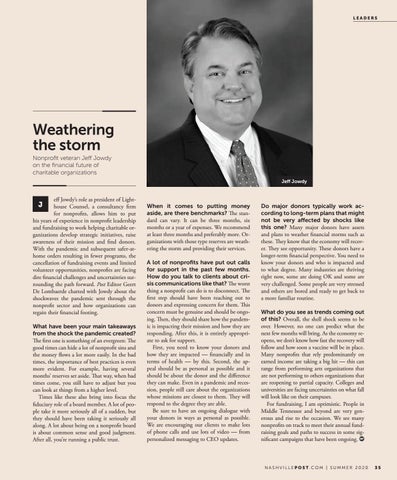LEADERS
Weathering the storm Nonprofit veteran Jeff Jowdy on the financial future of charitable organizations Jeff Jowdy
eff Jowdy’s role as president of Lighthouse Counsel, a consultancy firm for nonprofits, allows him to put his years of experience in nonprofit leadership and fundraising to work helping charitable organizations develop strategic initiatives, raise awareness of their mission and find donors. With the pandemic and subsequent safer-athome orders resulting in fewer programs, the cancellation of fundraising events and limited volunteer opportunities, nonprofits are facing dire financial challenges and uncertainties surrounding the path forward. Post Editor Geert De Lombaerde chatted with Jowdy about the shockwaves the pandemic sent through the nonprofit sector and how organizations can regain their financial footing.
J
What have been your main takeaways from the shock the pandemic created? The first one is something of an evergreen: The good times can hide a lot of nonprofit sins and the money flows a lot more easily. In the bad times, the importance of best practices is even more evident. For example, having several months’ reserves set aside. That way, when bad times come, you still have to adjust but you can look at things from a higher level. Times like these also bring into focus the fiduciary role of a board member. A lot of people take it more seriously all of a sudden, but they should have been taking it seriously all along. A lot about being on a nonprofit board is about common sense and good judgment. After all, you’re running a public trust.
When it comes to putting money aside, are there benchmarks? The standard can vary. It can be three months, six months or a year of expenses. We recommend at least three months and preferably more. Organizations with those type reserves are weathering the storm and providing their services. A lot of nonprofits have put out calls for support in the past few months. How do you talk to clients about crisis communications like that? The worst thing a nonprofit can do is to disconnect. The first step should have been reaching out to donors and expressing concern for them. This concern must be genuine and should be ongoing. Then, they should share how the pandemic is impacting their mission and how they are responding. After this, it is entirely appropriate to ask for support. First, you need to know your donors and how they are impacted — financially and in terms of health — by this. Second, the appeal should be as personal as possible and it should be about the donor and the difference they can make. Even in a pandemic and recession, people still care about the organizations whose missions are closest to them. They will respond to the degree they are able. Be sure to have an ongoing dialogue with your donors in ways as personal as possible. We are encouraging our clients to make lots of phone calls and use lots of video — from personalized messaging to CEO updates.
Do major donors typically work according to long-term plans that might not be very affected by shocks like this one? Many major donors have assets and plans to weather financial storms such as these. They know that the economy will recover. They see opportunity. These donors have a longer-term financial perspective. You need to know your donors and who is impacted and to what degree. Many industries are thriving right now, some are doing OK and some are very challenged. Some people are very stressed and others are bored and ready to get back to a more familiar routine. What do you see as trends coming out of this? Overall, the shell shock seems to be over. However, no one can predict what the next few months will bring. As the economy reopens, we don’t know how fast the recovery will follow and how soon a vaccine will be in place. Many nonprofits that rely predominantly on earned income are taking a big hit — this can range from performing arts organizations that are not performing to others organizations that are reopening to partial capacity. Colleges and universities are facing uncertainties on what fall will look like on their campuses. For fundraising, I am optimistic. People in Middle Tennessee and beyond are very generous and rise to the occasion. We see many nonprofits on track to meet their annual fundraising goals and paths to success in some significant campaigns that have been ongoing.
NASHVILLEPOST.COM | SUMMER 2020
35












